Evaluating Activity-Based Costing in Managerial Accounting HI5017
VerifiedAdded on 2023/06/04
|18
|3905
|206
Report
AI Summary
This report evaluates the implications of the activity-based costing (ABC) system from a business perspective, utilizing two journal articles from different industries to assess its effectiveness in enhancing cost reporting. The study compares the traditional costing system with the ABC system, highlighting the benefits and challenges of implementing ABC in both public and service sectors. Key research questions address the implementation of ABC in public firms, its applicability to organizations with limited size and product lines, and the advantages gained by applying the ABC system. The analysis identifies similarities and differences between the two studies, focusing on improvements in cost projections and the elimination of loopholes in traditional costing methods. The report concludes with specific outcomes and recommendations for Australian management accountants to improve their management accounting procedures.
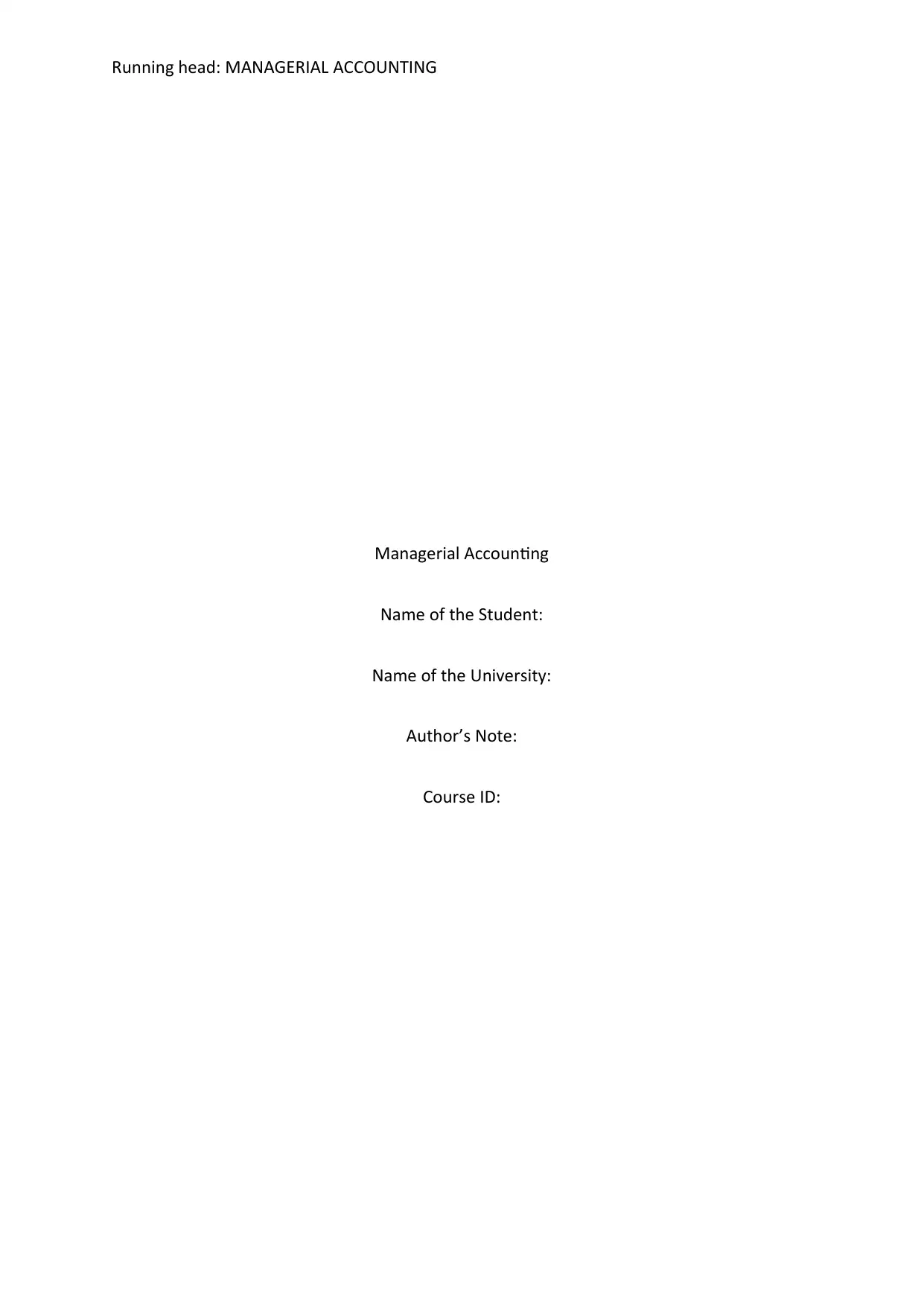
Running head: MANAGERIAL ACCOUNTING
Managerial Accounting
Name of the Student:
Name of the University:
Author’s Note:
Course ID:
Managerial Accounting
Name of the Student:
Name of the University:
Author’s Note:
Course ID:
Paraphrase This Document
Need a fresh take? Get an instant paraphrase of this document with our AI Paraphraser
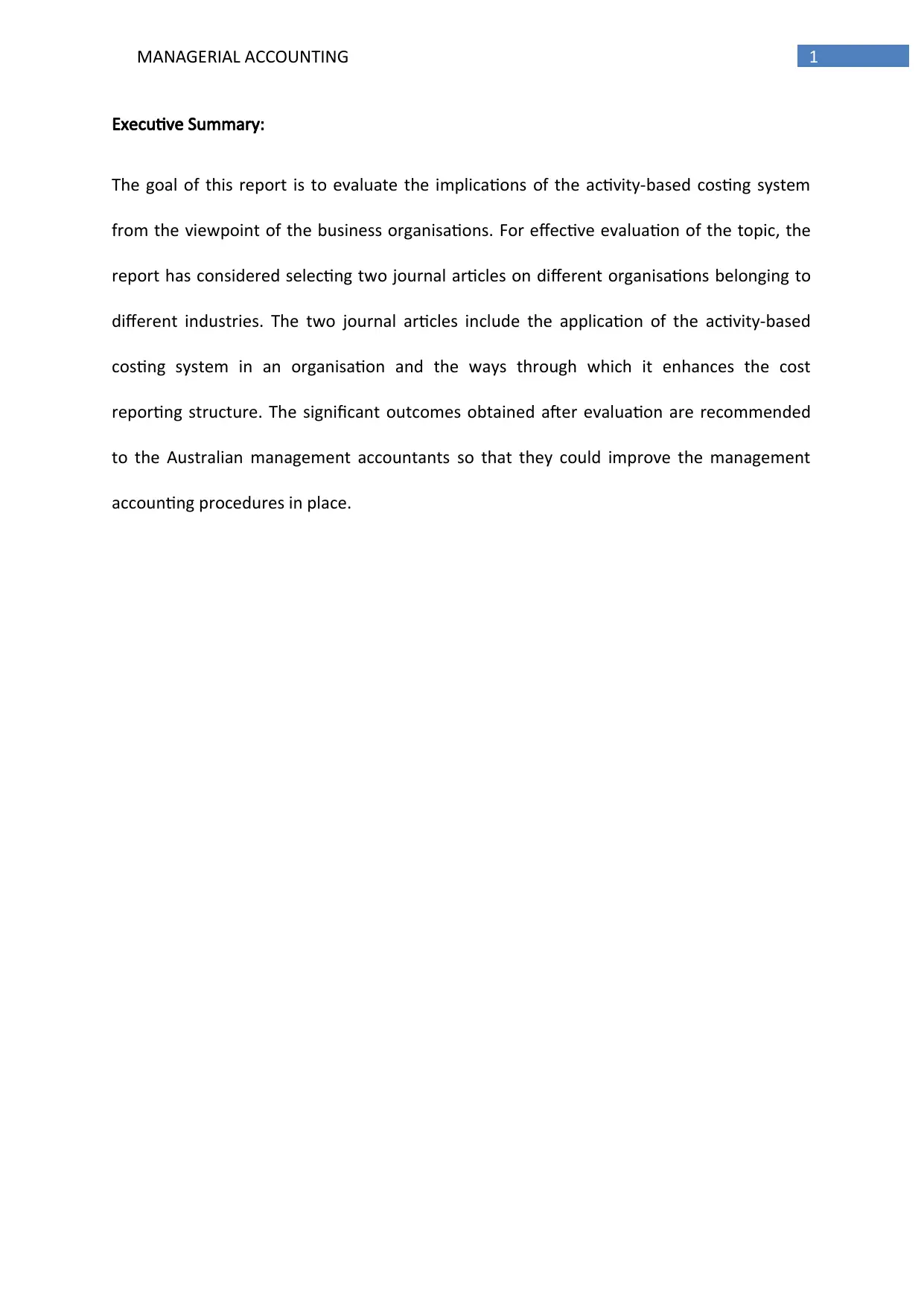
1MANAGERIAL ACCOUNTING
Executive Summary:
The goal of this report is to evaluate the implications of the activity-based costing system
from the viewpoint of the business organisations. For effective evaluation of the topic, the
report has considered selecting two journal articles on different organisations belonging to
different industries. The two journal articles include the application of the activity-based
costing system in an organisation and the ways through which it enhances the cost
reporting structure. The significant outcomes obtained after evaluation are recommended
to the Australian management accountants so that they could improve the management
accounting procedures in place.
Executive Summary:
The goal of this report is to evaluate the implications of the activity-based costing system
from the viewpoint of the business organisations. For effective evaluation of the topic, the
report has considered selecting two journal articles on different organisations belonging to
different industries. The two journal articles include the application of the activity-based
costing system in an organisation and the ways through which it enhances the cost
reporting structure. The significant outcomes obtained after evaluation are recommended
to the Australian management accountants so that they could improve the management
accounting procedures in place.
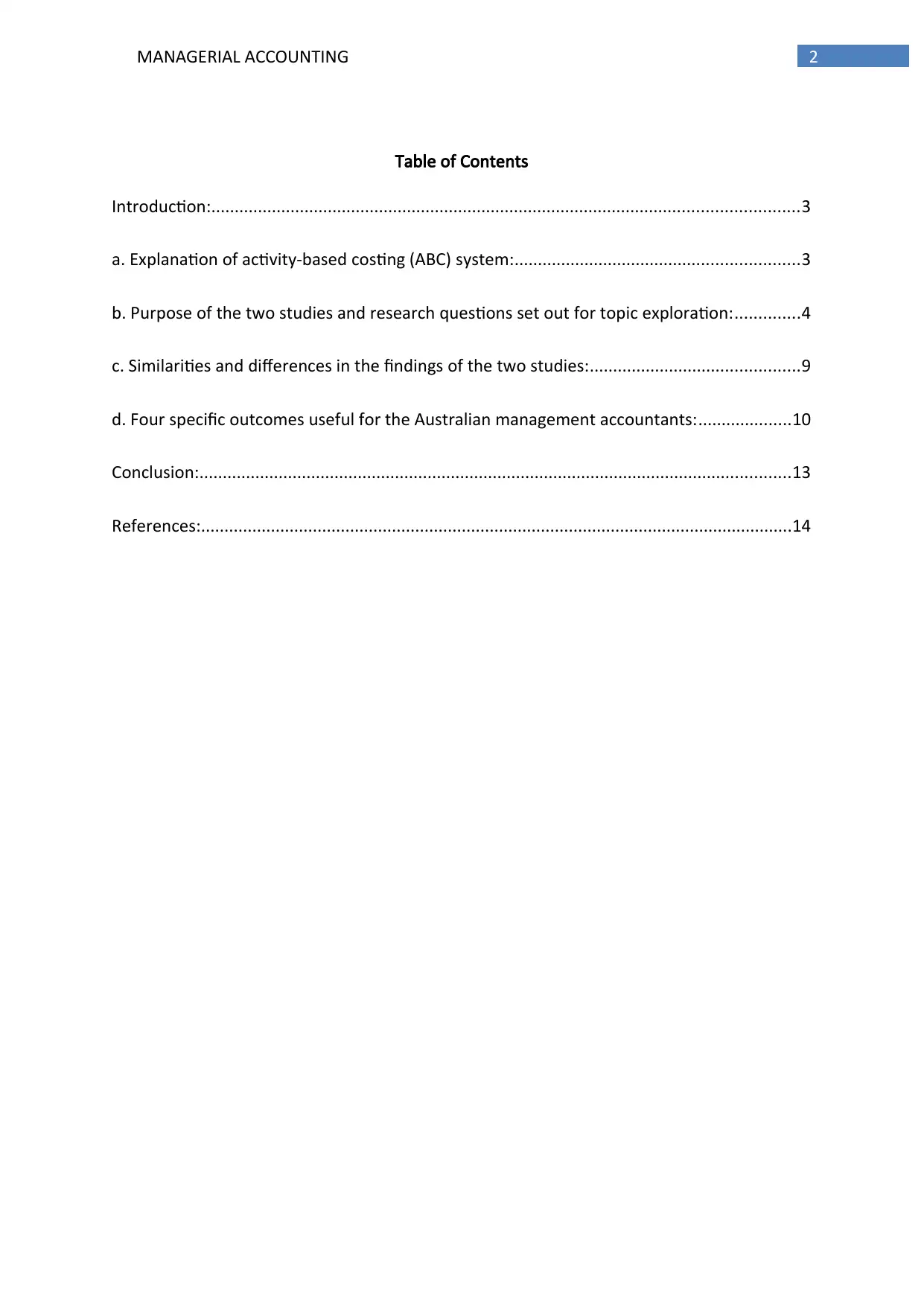
2MANAGERIAL ACCOUNTING
Table of Contents
Introduction:..............................................................................................................................3
a. Explanation of activity-based costing (ABC) system:.............................................................3
b. Purpose of the two studies and research questions set out for topic exploration:..............4
c. Similarities and differences in the findings of the two studies:.............................................9
d. Four specific outcomes useful for the Australian management accountants:....................10
Conclusion:...............................................................................................................................13
References:...............................................................................................................................14
Table of Contents
Introduction:..............................................................................................................................3
a. Explanation of activity-based costing (ABC) system:.............................................................3
b. Purpose of the two studies and research questions set out for topic exploration:..............4
c. Similarities and differences in the findings of the two studies:.............................................9
d. Four specific outcomes useful for the Australian management accountants:....................10
Conclusion:...............................................................................................................................13
References:...............................................................................................................................14
⊘ This is a preview!⊘
Do you want full access?
Subscribe today to unlock all pages.

Trusted by 1+ million students worldwide
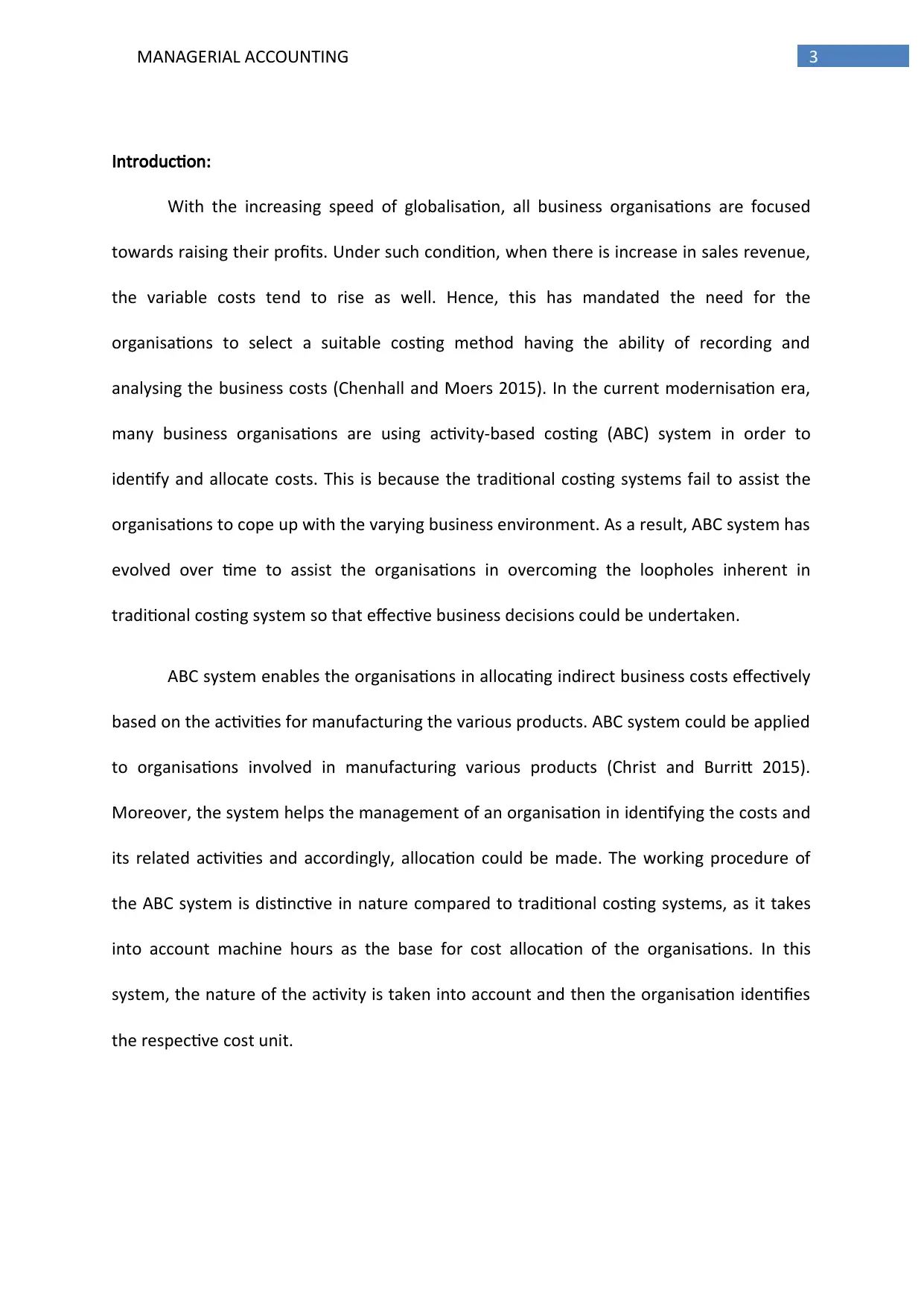
3MANAGERIAL ACCOUNTING
Introduction:
With the increasing speed of globalisation, all business organisations are focused
towards raising their profits. Under such condition, when there is increase in sales revenue,
the variable costs tend to rise as well. Hence, this has mandated the need for the
organisations to select a suitable costing method having the ability of recording and
analysing the business costs (Chenhall and Moers 2015). In the current modernisation era,
many business organisations are using activity-based costing (ABC) system in order to
identify and allocate costs. This is because the traditional costing systems fail to assist the
organisations to cope up with the varying business environment. As a result, ABC system has
evolved over time to assist the organisations in overcoming the loopholes inherent in
traditional costing system so that effective business decisions could be undertaken.
ABC system enables the organisations in allocating indirect business costs effectively
based on the activities for manufacturing the various products. ABC system could be applied
to organisations involved in manufacturing various products (Christ and Burritt 2015).
Moreover, the system helps the management of an organisation in identifying the costs and
its related activities and accordingly, allocation could be made. The working procedure of
the ABC system is distinctive in nature compared to traditional costing systems, as it takes
into account machine hours as the base for cost allocation of the organisations. In this
system, the nature of the activity is taken into account and then the organisation identifies
the respective cost unit.
Introduction:
With the increasing speed of globalisation, all business organisations are focused
towards raising their profits. Under such condition, when there is increase in sales revenue,
the variable costs tend to rise as well. Hence, this has mandated the need for the
organisations to select a suitable costing method having the ability of recording and
analysing the business costs (Chenhall and Moers 2015). In the current modernisation era,
many business organisations are using activity-based costing (ABC) system in order to
identify and allocate costs. This is because the traditional costing systems fail to assist the
organisations to cope up with the varying business environment. As a result, ABC system has
evolved over time to assist the organisations in overcoming the loopholes inherent in
traditional costing system so that effective business decisions could be undertaken.
ABC system enables the organisations in allocating indirect business costs effectively
based on the activities for manufacturing the various products. ABC system could be applied
to organisations involved in manufacturing various products (Christ and Burritt 2015).
Moreover, the system helps the management of an organisation in identifying the costs and
its related activities and accordingly, allocation could be made. The working procedure of
the ABC system is distinctive in nature compared to traditional costing systems, as it takes
into account machine hours as the base for cost allocation of the organisations. In this
system, the nature of the activity is taken into account and then the organisation identifies
the respective cost unit.
Paraphrase This Document
Need a fresh take? Get an instant paraphrase of this document with our AI Paraphraser
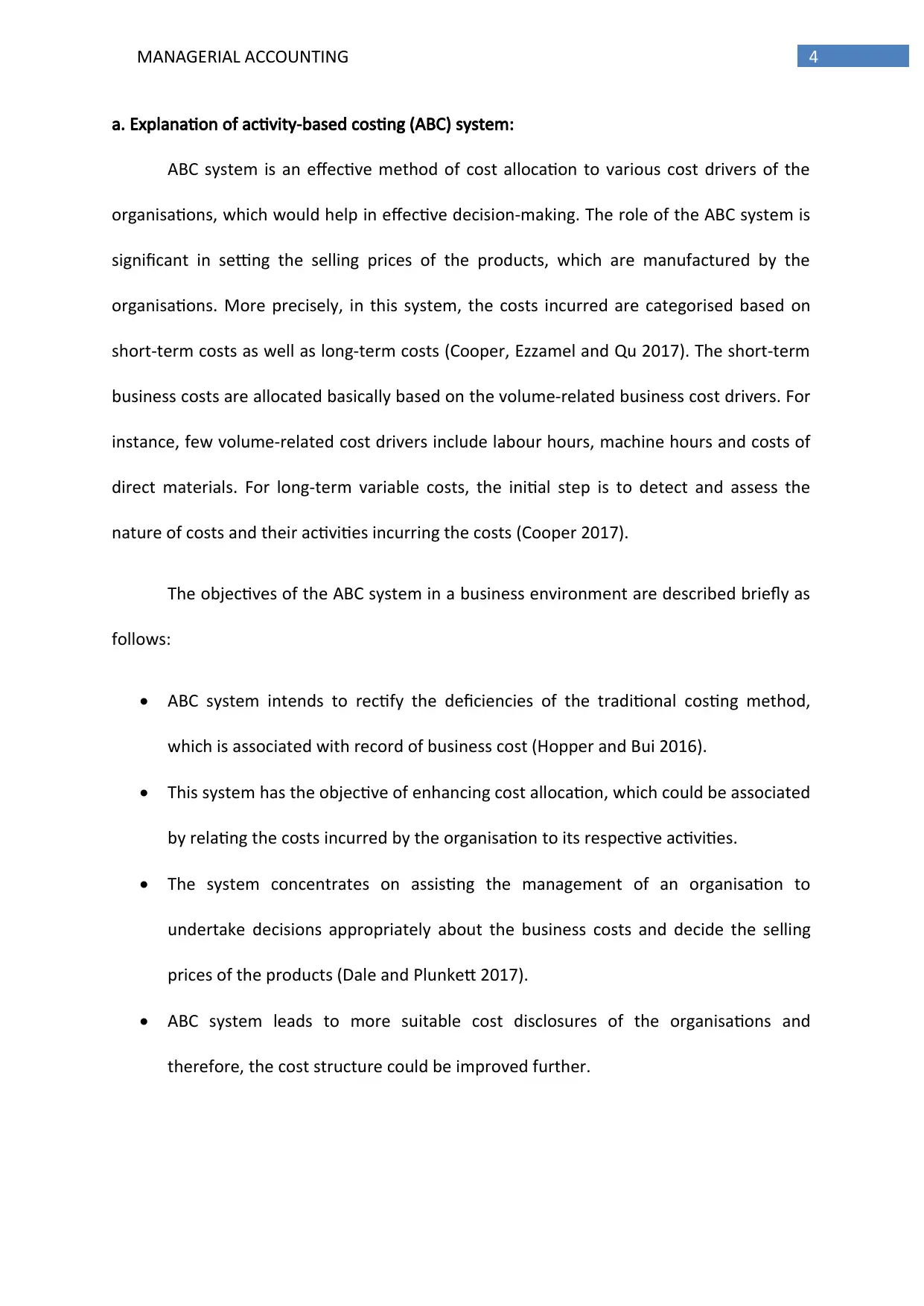
4MANAGERIAL ACCOUNTING
a. Explanation of activity-based costing (ABC) system:
ABC system is an effective method of cost allocation to various cost drivers of the
organisations, which would help in effective decision-making. The role of the ABC system is
significant in setting the selling prices of the products, which are manufactured by the
organisations. More precisely, in this system, the costs incurred are categorised based on
short-term costs as well as long-term costs (Cooper, Ezzamel and Qu 2017). The short-term
business costs are allocated basically based on the volume-related business cost drivers. For
instance, few volume-related cost drivers include labour hours, machine hours and costs of
direct materials. For long-term variable costs, the initial step is to detect and assess the
nature of costs and their activities incurring the costs (Cooper 2017).
The objectives of the ABC system in a business environment are described briefly as
follows:
ABC system intends to rectify the deficiencies of the traditional costing method,
which is associated with record of business cost (Hopper and Bui 2016).
This system has the objective of enhancing cost allocation, which could be associated
by relating the costs incurred by the organisation to its respective activities.
The system concentrates on assisting the management of an organisation to
undertake decisions appropriately about the business costs and decide the selling
prices of the products (Dale and Plunkett 2017).
ABC system leads to more suitable cost disclosures of the organisations and
therefore, the cost structure could be improved further.
a. Explanation of activity-based costing (ABC) system:
ABC system is an effective method of cost allocation to various cost drivers of the
organisations, which would help in effective decision-making. The role of the ABC system is
significant in setting the selling prices of the products, which are manufactured by the
organisations. More precisely, in this system, the costs incurred are categorised based on
short-term costs as well as long-term costs (Cooper, Ezzamel and Qu 2017). The short-term
business costs are allocated basically based on the volume-related business cost drivers. For
instance, few volume-related cost drivers include labour hours, machine hours and costs of
direct materials. For long-term variable costs, the initial step is to detect and assess the
nature of costs and their activities incurring the costs (Cooper 2017).
The objectives of the ABC system in a business environment are described briefly as
follows:
ABC system intends to rectify the deficiencies of the traditional costing method,
which is associated with record of business cost (Hopper and Bui 2016).
This system has the objective of enhancing cost allocation, which could be associated
by relating the costs incurred by the organisation to its respective activities.
The system concentrates on assisting the management of an organisation to
undertake decisions appropriately about the business costs and decide the selling
prices of the products (Dale and Plunkett 2017).
ABC system leads to more suitable cost disclosures of the organisations and
therefore, the cost structure could be improved further.
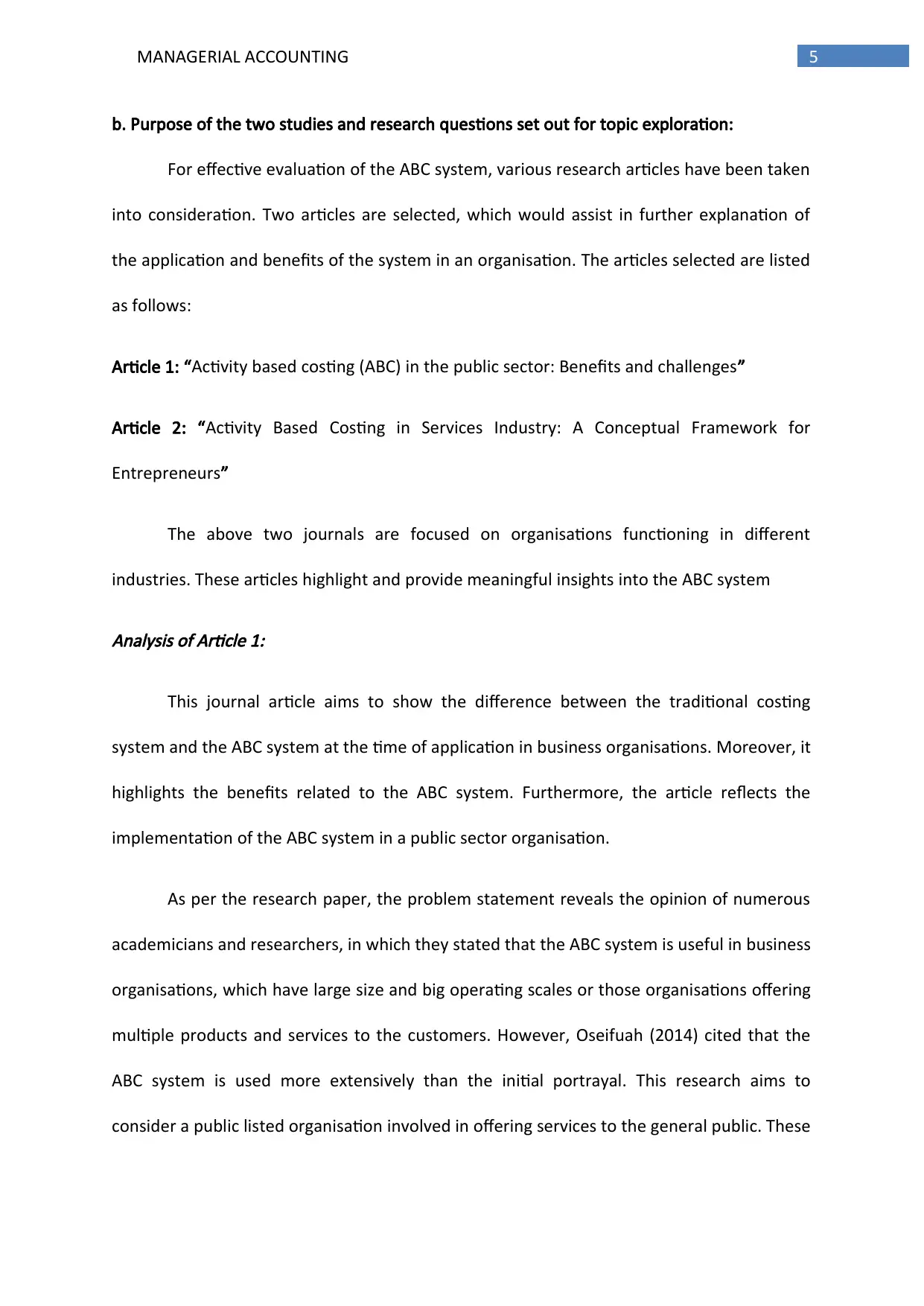
5MANAGERIAL ACCOUNTING
b. Purpose of the two studies and research questions set out for topic exploration:
For effective evaluation of the ABC system, various research articles have been taken
into consideration. Two articles are selected, which would assist in further explanation of
the application and benefits of the system in an organisation. The articles selected are listed
as follows:
Article 1: “Activity based costing (ABC) in the public sector: Benefits and challenges”
Article 2: “Activity Based Costing in Services Industry: A Conceptual Framework for
Entrepreneurs”
The above two journals are focused on organisations functioning in different
industries. These articles highlight and provide meaningful insights into the ABC system
Analysis of Article 1:
This journal article aims to show the difference between the traditional costing
system and the ABC system at the time of application in business organisations. Moreover, it
highlights the benefits related to the ABC system. Furthermore, the article reflects the
implementation of the ABC system in a public sector organisation.
As per the research paper, the problem statement reveals the opinion of numerous
academicians and researchers, in which they stated that the ABC system is useful in business
organisations, which have large size and big operating scales or those organisations offering
multiple products and services to the customers. However, Oseifuah (2014) cited that the
ABC system is used more extensively than the initial portrayal. This research aims to
consider a public listed organisation involved in offering services to the general public. These
b. Purpose of the two studies and research questions set out for topic exploration:
For effective evaluation of the ABC system, various research articles have been taken
into consideration. Two articles are selected, which would assist in further explanation of
the application and benefits of the system in an organisation. The articles selected are listed
as follows:
Article 1: “Activity based costing (ABC) in the public sector: Benefits and challenges”
Article 2: “Activity Based Costing in Services Industry: A Conceptual Framework for
Entrepreneurs”
The above two journals are focused on organisations functioning in different
industries. These articles highlight and provide meaningful insights into the ABC system
Analysis of Article 1:
This journal article aims to show the difference between the traditional costing
system and the ABC system at the time of application in business organisations. Moreover, it
highlights the benefits related to the ABC system. Furthermore, the article reflects the
implementation of the ABC system in a public sector organisation.
As per the research paper, the problem statement reveals the opinion of numerous
academicians and researchers, in which they stated that the ABC system is useful in business
organisations, which have large size and big operating scales or those organisations offering
multiple products and services to the customers. However, Oseifuah (2014) cited that the
ABC system is used more extensively than the initial portrayal. This research aims to
consider a public listed organisation involved in offering services to the general public. These
⊘ This is a preview!⊘
Do you want full access?
Subscribe today to unlock all pages.

Trusted by 1+ million students worldwide
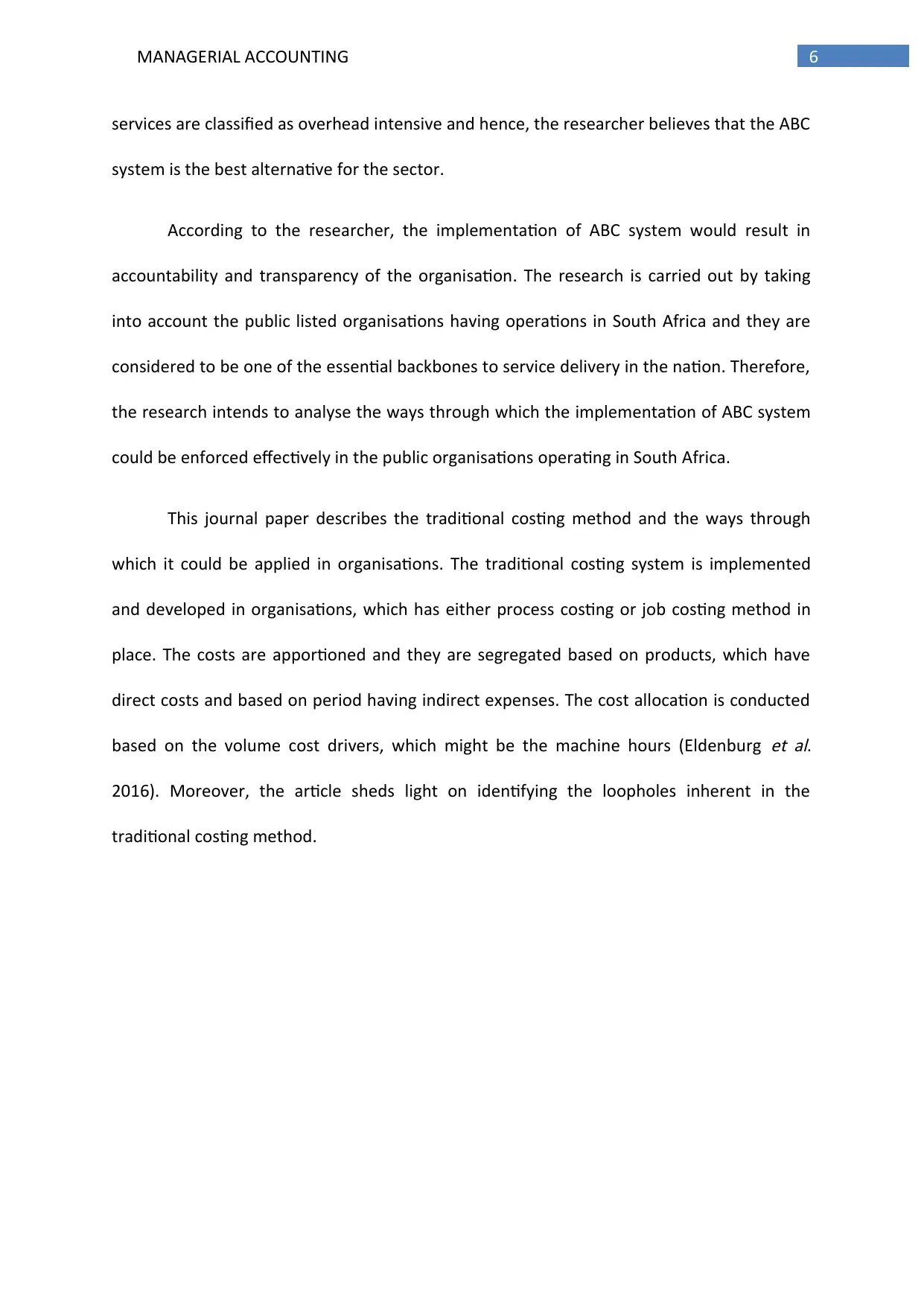
6MANAGERIAL ACCOUNTING
services are classified as overhead intensive and hence, the researcher believes that the ABC
system is the best alternative for the sector.
According to the researcher, the implementation of ABC system would result in
accountability and transparency of the organisation. The research is carried out by taking
into account the public listed organisations having operations in South Africa and they are
considered to be one of the essential backbones to service delivery in the nation. Therefore,
the research intends to analyse the ways through which the implementation of ABC system
could be enforced effectively in the public organisations operating in South Africa.
This journal paper describes the traditional costing method and the ways through
which it could be applied in organisations. The traditional costing system is implemented
and developed in organisations, which has either process costing or job costing method in
place. The costs are apportioned and they are segregated based on products, which have
direct costs and based on period having indirect expenses. The cost allocation is conducted
based on the volume cost drivers, which might be the machine hours (Eldenburg
et al.
2016). Moreover, the article sheds light on identifying the loopholes inherent in the
traditional costing method.
services are classified as overhead intensive and hence, the researcher believes that the ABC
system is the best alternative for the sector.
According to the researcher, the implementation of ABC system would result in
accountability and transparency of the organisation. The research is carried out by taking
into account the public listed organisations having operations in South Africa and they are
considered to be one of the essential backbones to service delivery in the nation. Therefore,
the research intends to analyse the ways through which the implementation of ABC system
could be enforced effectively in the public organisations operating in South Africa.
This journal paper describes the traditional costing method and the ways through
which it could be applied in organisations. The traditional costing system is implemented
and developed in organisations, which has either process costing or job costing method in
place. The costs are apportioned and they are segregated based on products, which have
direct costs and based on period having indirect expenses. The cost allocation is conducted
based on the volume cost drivers, which might be the machine hours (Eldenburg
et al.
2016). Moreover, the article sheds light on identifying the loopholes inherent in the
traditional costing method.
Paraphrase This Document
Need a fresh take? Get an instant paraphrase of this document with our AI Paraphraser
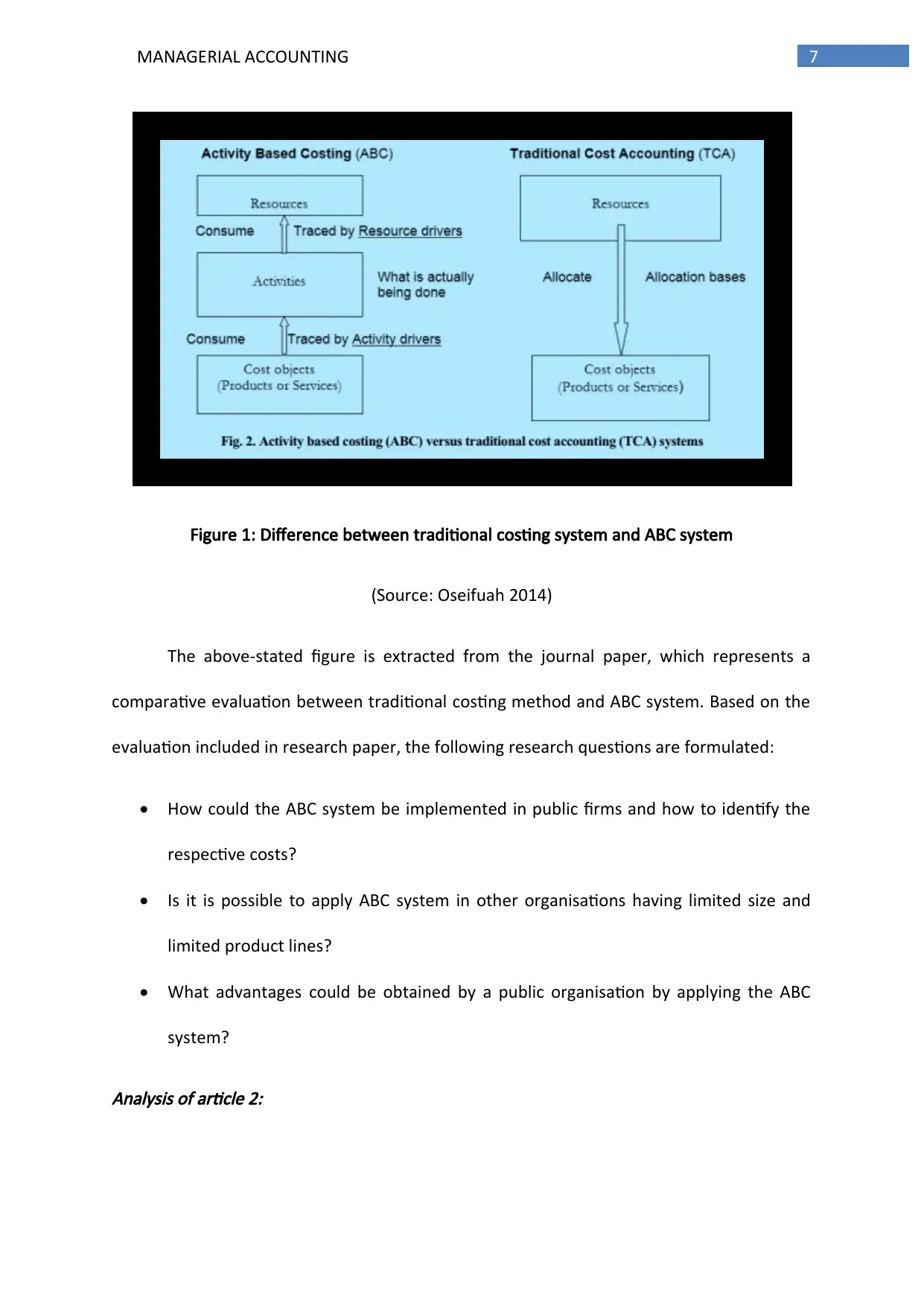
7MANAGERIAL ACCOUNTING
Figure 1: Difference between traditional costing system and ABC system
(Source: Oseifuah 2014)
The above-stated figure is extracted from the journal paper, which represents a
comparative evaluation between traditional costing method and ABC system. Based on the
evaluation included in research paper, the following research questions are formulated:
How could the ABC system be implemented in public firms and how to identify the
respective costs?
Is it is possible to apply ABC system in other organisations having limited size and
limited product lines?
What advantages could be obtained by a public organisation by applying the ABC
system?
Analysis of article 2:
Figure 1: Difference between traditional costing system and ABC system
(Source: Oseifuah 2014)
The above-stated figure is extracted from the journal paper, which represents a
comparative evaluation between traditional costing method and ABC system. Based on the
evaluation included in research paper, the following research questions are formulated:
How could the ABC system be implemented in public firms and how to identify the
respective costs?
Is it is possible to apply ABC system in other organisations having limited size and
limited product lines?
What advantages could be obtained by a public organisation by applying the ABC
system?
Analysis of article 2:
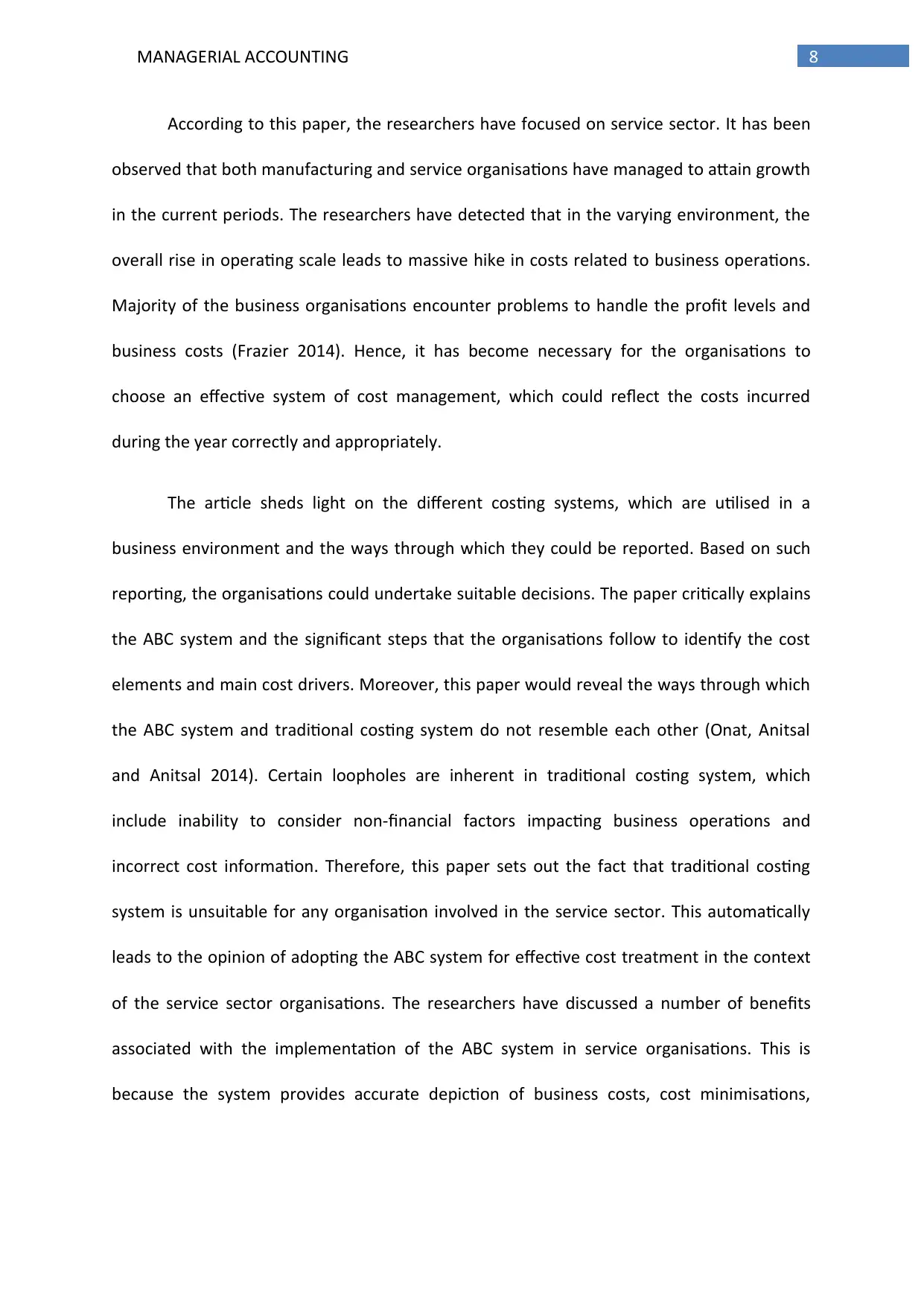
8MANAGERIAL ACCOUNTING
According to this paper, the researchers have focused on service sector. It has been
observed that both manufacturing and service organisations have managed to attain growth
in the current periods. The researchers have detected that in the varying environment, the
overall rise in operating scale leads to massive hike in costs related to business operations.
Majority of the business organisations encounter problems to handle the profit levels and
business costs (Frazier 2014). Hence, it has become necessary for the organisations to
choose an effective system of cost management, which could reflect the costs incurred
during the year correctly and appropriately.
The article sheds light on the different costing systems, which are utilised in a
business environment and the ways through which they could be reported. Based on such
reporting, the organisations could undertake suitable decisions. The paper critically explains
the ABC system and the significant steps that the organisations follow to identify the cost
elements and main cost drivers. Moreover, this paper would reveal the ways through which
the ABC system and traditional costing system do not resemble each other (Onat, Anitsal
and Anitsal 2014). Certain loopholes are inherent in traditional costing system, which
include inability to consider non-financial factors impacting business operations and
incorrect cost information. Therefore, this paper sets out the fact that traditional costing
system is unsuitable for any organisation involved in the service sector. This automatically
leads to the opinion of adopting the ABC system for effective cost treatment in the context
of the service sector organisations. The researchers have discussed a number of benefits
associated with the implementation of the ABC system in service organisations. This is
because the system provides accurate depiction of business costs, cost minimisations,
According to this paper, the researchers have focused on service sector. It has been
observed that both manufacturing and service organisations have managed to attain growth
in the current periods. The researchers have detected that in the varying environment, the
overall rise in operating scale leads to massive hike in costs related to business operations.
Majority of the business organisations encounter problems to handle the profit levels and
business costs (Frazier 2014). Hence, it has become necessary for the organisations to
choose an effective system of cost management, which could reflect the costs incurred
during the year correctly and appropriately.
The article sheds light on the different costing systems, which are utilised in a
business environment and the ways through which they could be reported. Based on such
reporting, the organisations could undertake suitable decisions. The paper critically explains
the ABC system and the significant steps that the organisations follow to identify the cost
elements and main cost drivers. Moreover, this paper would reveal the ways through which
the ABC system and traditional costing system do not resemble each other (Onat, Anitsal
and Anitsal 2014). Certain loopholes are inherent in traditional costing system, which
include inability to consider non-financial factors impacting business operations and
incorrect cost information. Therefore, this paper sets out the fact that traditional costing
system is unsuitable for any organisation involved in the service sector. This automatically
leads to the opinion of adopting the ABC system for effective cost treatment in the context
of the service sector organisations. The researchers have discussed a number of benefits
associated with the implementation of the ABC system in service organisations. This is
because the system provides accurate depiction of business costs, cost minimisations,
⊘ This is a preview!⊘
Do you want full access?
Subscribe today to unlock all pages.

Trusted by 1+ million students worldwide
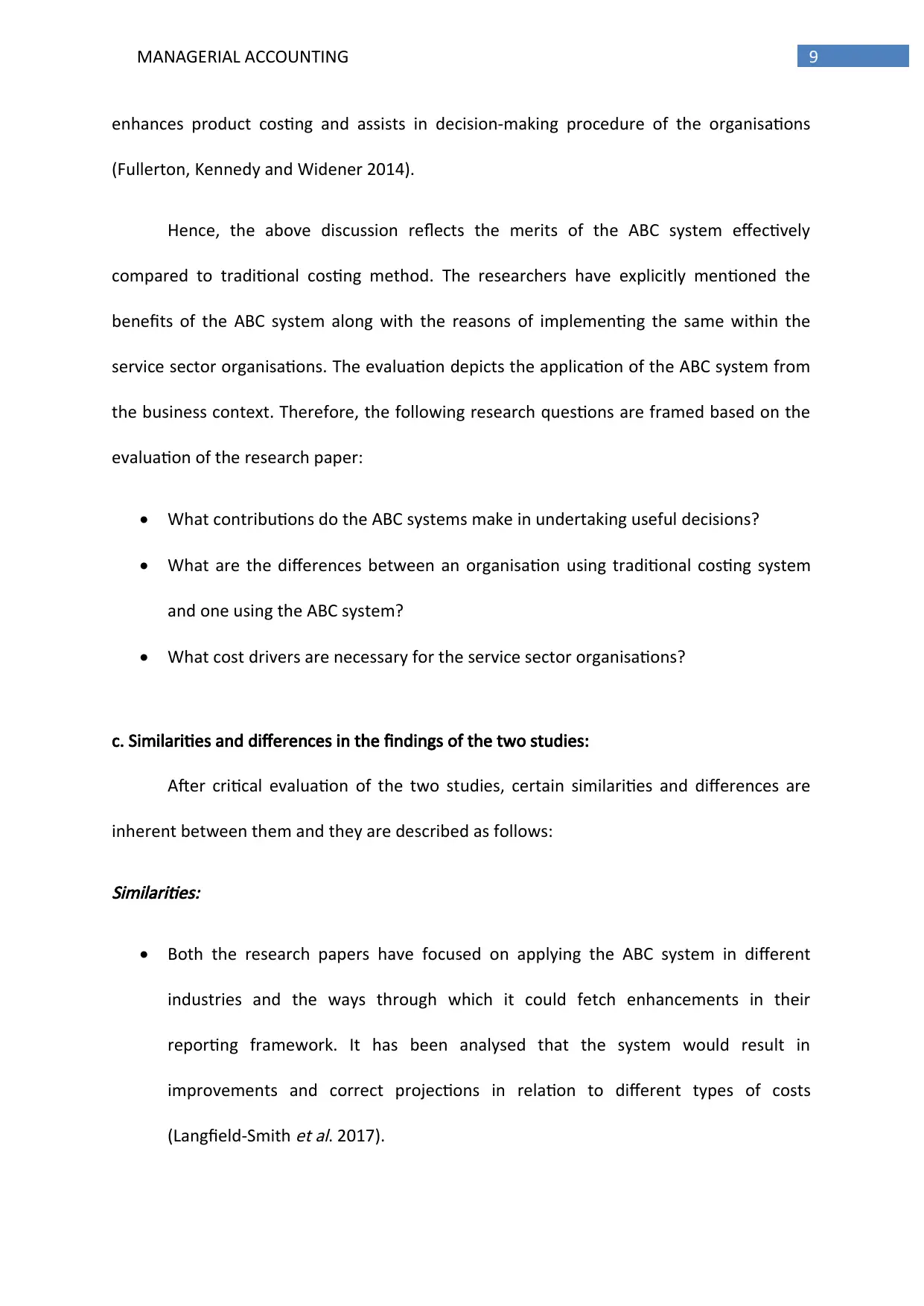
9MANAGERIAL ACCOUNTING
enhances product costing and assists in decision-making procedure of the organisations
(Fullerton, Kennedy and Widener 2014).
Hence, the above discussion reflects the merits of the ABC system effectively
compared to traditional costing method. The researchers have explicitly mentioned the
benefits of the ABC system along with the reasons of implementing the same within the
service sector organisations. The evaluation depicts the application of the ABC system from
the business context. Therefore, the following research questions are framed based on the
evaluation of the research paper:
What contributions do the ABC systems make in undertaking useful decisions?
What are the differences between an organisation using traditional costing system
and one using the ABC system?
What cost drivers are necessary for the service sector organisations?
c. Similarities and differences in the findings of the two studies:
After critical evaluation of the two studies, certain similarities and differences are
inherent between them and they are described as follows:
Similarities:
Both the research papers have focused on applying the ABC system in different
industries and the ways through which it could fetch enhancements in their
reporting framework. It has been analysed that the system would result in
improvements and correct projections in relation to different types of costs
(Langfield-Smith
et al. 2017).
enhances product costing and assists in decision-making procedure of the organisations
(Fullerton, Kennedy and Widener 2014).
Hence, the above discussion reflects the merits of the ABC system effectively
compared to traditional costing method. The researchers have explicitly mentioned the
benefits of the ABC system along with the reasons of implementing the same within the
service sector organisations. The evaluation depicts the application of the ABC system from
the business context. Therefore, the following research questions are framed based on the
evaluation of the research paper:
What contributions do the ABC systems make in undertaking useful decisions?
What are the differences between an organisation using traditional costing system
and one using the ABC system?
What cost drivers are necessary for the service sector organisations?
c. Similarities and differences in the findings of the two studies:
After critical evaluation of the two studies, certain similarities and differences are
inherent between them and they are described as follows:
Similarities:
Both the research papers have focused on applying the ABC system in different
industries and the ways through which it could fetch enhancements in their
reporting framework. It has been analysed that the system would result in
improvements and correct projections in relation to different types of costs
(Langfield-Smith
et al. 2017).
Paraphrase This Document
Need a fresh take? Get an instant paraphrase of this document with our AI Paraphraser
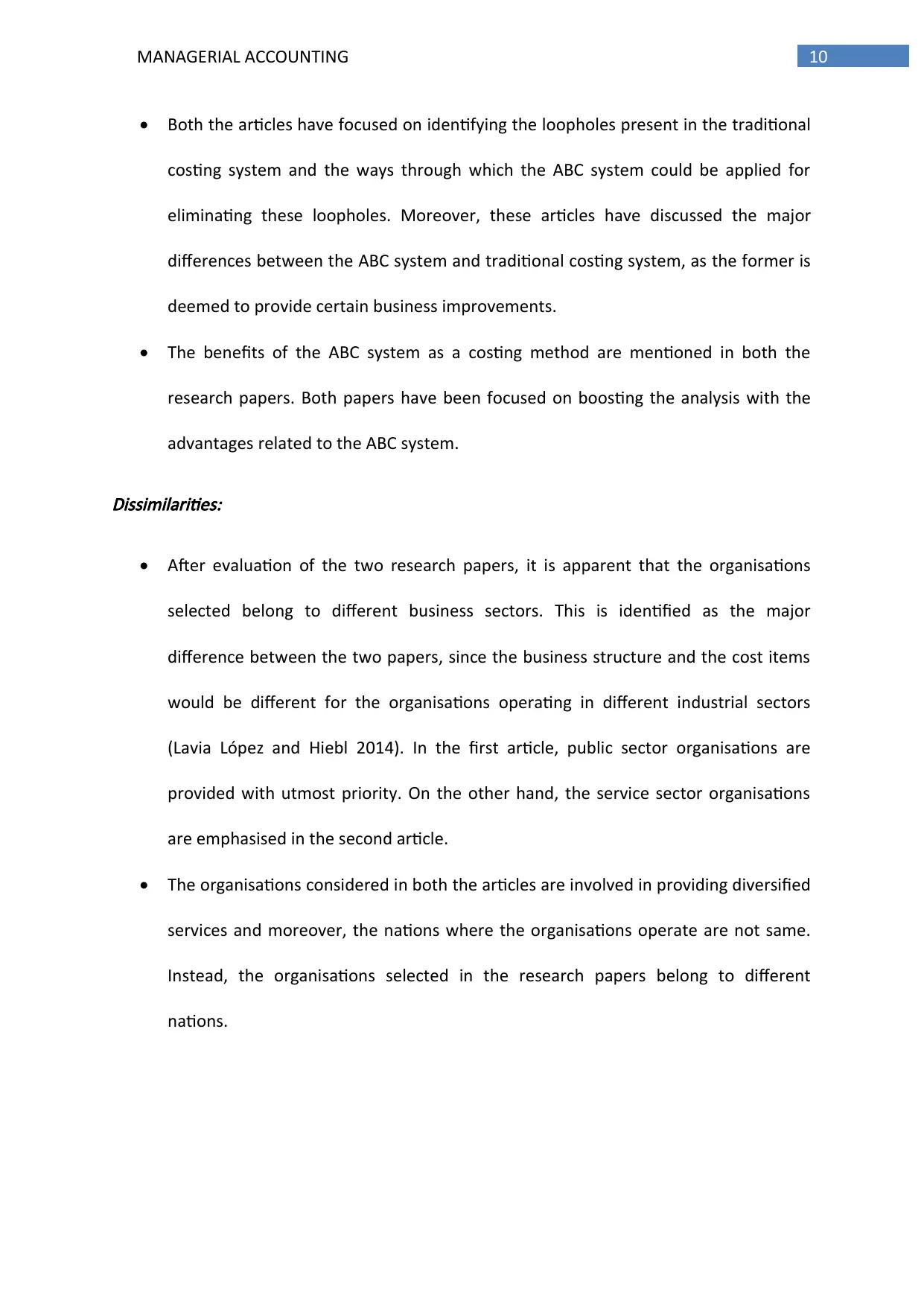
10MANAGERIAL ACCOUNTING
Both the articles have focused on identifying the loopholes present in the traditional
costing system and the ways through which the ABC system could be applied for
eliminating these loopholes. Moreover, these articles have discussed the major
differences between the ABC system and traditional costing system, as the former is
deemed to provide certain business improvements.
The benefits of the ABC system as a costing method are mentioned in both the
research papers. Both papers have been focused on boosting the analysis with the
advantages related to the ABC system.
Dissimilarities:
After evaluation of the two research papers, it is apparent that the organisations
selected belong to different business sectors. This is identified as the major
difference between the two papers, since the business structure and the cost items
would be different for the organisations operating in different industrial sectors
(Lavia López and Hiebl 2014). In the first article, public sector organisations are
provided with utmost priority. On the other hand, the service sector organisations
are emphasised in the second article.
The organisations considered in both the articles are involved in providing diversified
services and moreover, the nations where the organisations operate are not same.
Instead, the organisations selected in the research papers belong to different
nations.
Both the articles have focused on identifying the loopholes present in the traditional
costing system and the ways through which the ABC system could be applied for
eliminating these loopholes. Moreover, these articles have discussed the major
differences between the ABC system and traditional costing system, as the former is
deemed to provide certain business improvements.
The benefits of the ABC system as a costing method are mentioned in both the
research papers. Both papers have been focused on boosting the analysis with the
advantages related to the ABC system.
Dissimilarities:
After evaluation of the two research papers, it is apparent that the organisations
selected belong to different business sectors. This is identified as the major
difference between the two papers, since the business structure and the cost items
would be different for the organisations operating in different industrial sectors
(Lavia López and Hiebl 2014). In the first article, public sector organisations are
provided with utmost priority. On the other hand, the service sector organisations
are emphasised in the second article.
The organisations considered in both the articles are involved in providing diversified
services and moreover, the nations where the organisations operate are not same.
Instead, the organisations selected in the research papers belong to different
nations.
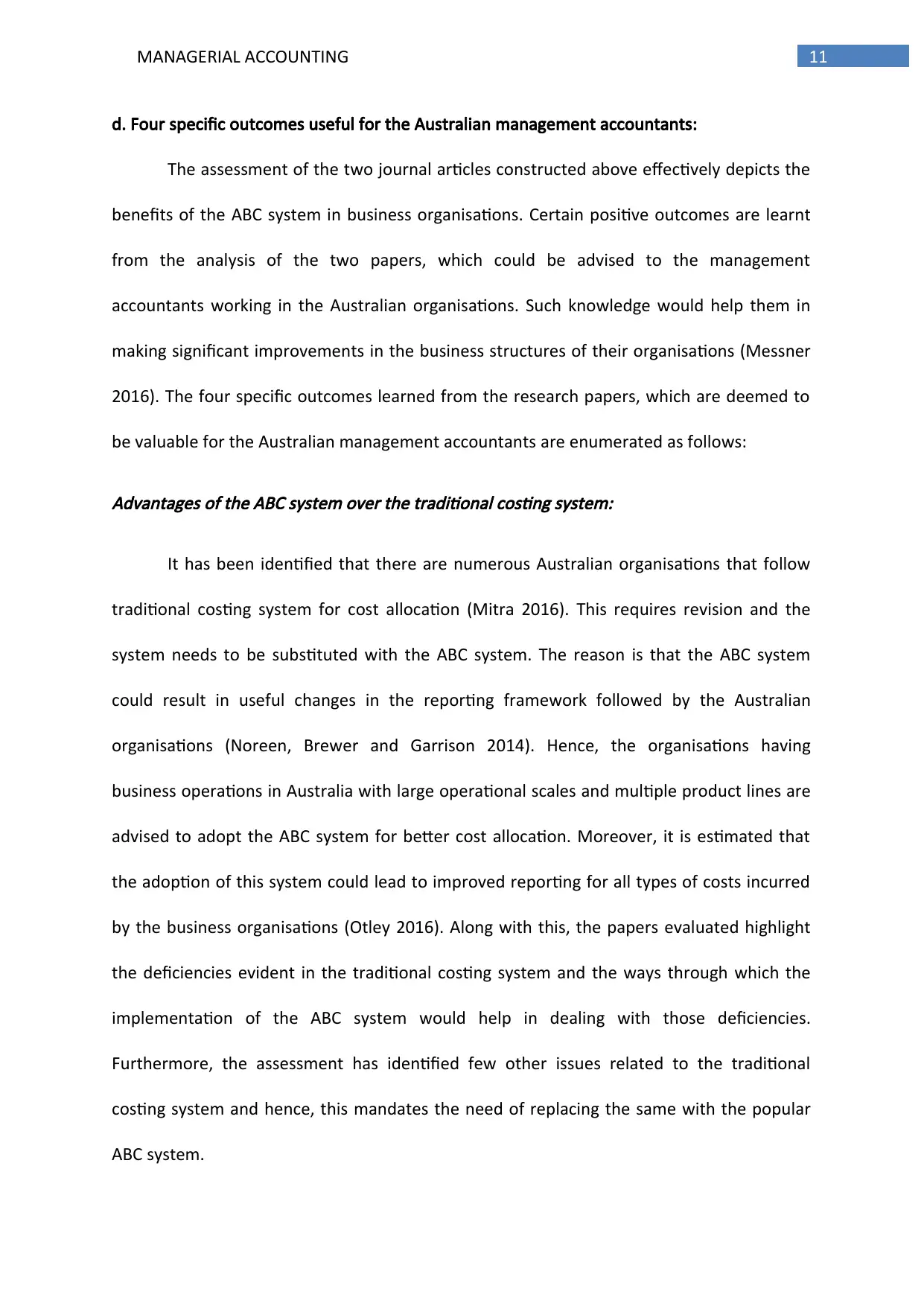
11MANAGERIAL ACCOUNTING
d. Four specific outcomes useful for the Australian management accountants:
The assessment of the two journal articles constructed above effectively depicts the
benefits of the ABC system in business organisations. Certain positive outcomes are learnt
from the analysis of the two papers, which could be advised to the management
accountants working in the Australian organisations. Such knowledge would help them in
making significant improvements in the business structures of their organisations (Messner
2016). The four specific outcomes learned from the research papers, which are deemed to
be valuable for the Australian management accountants are enumerated as follows:
Advantages of the ABC system over the traditional costing system:
It has been identified that there are numerous Australian organisations that follow
traditional costing system for cost allocation (Mitra 2016). This requires revision and the
system needs to be substituted with the ABC system. The reason is that the ABC system
could result in useful changes in the reporting framework followed by the Australian
organisations (Noreen, Brewer and Garrison 2014). Hence, the organisations having
business operations in Australia with large operational scales and multiple product lines are
advised to adopt the ABC system for better cost allocation. Moreover, it is estimated that
the adoption of this system could lead to improved reporting for all types of costs incurred
by the business organisations (Otley 2016). Along with this, the papers evaluated highlight
the deficiencies evident in the traditional costing system and the ways through which the
implementation of the ABC system would help in dealing with those deficiencies.
Furthermore, the assessment has identified few other issues related to the traditional
costing system and hence, this mandates the need of replacing the same with the popular
ABC system.
d. Four specific outcomes useful for the Australian management accountants:
The assessment of the two journal articles constructed above effectively depicts the
benefits of the ABC system in business organisations. Certain positive outcomes are learnt
from the analysis of the two papers, which could be advised to the management
accountants working in the Australian organisations. Such knowledge would help them in
making significant improvements in the business structures of their organisations (Messner
2016). The four specific outcomes learned from the research papers, which are deemed to
be valuable for the Australian management accountants are enumerated as follows:
Advantages of the ABC system over the traditional costing system:
It has been identified that there are numerous Australian organisations that follow
traditional costing system for cost allocation (Mitra 2016). This requires revision and the
system needs to be substituted with the ABC system. The reason is that the ABC system
could result in useful changes in the reporting framework followed by the Australian
organisations (Noreen, Brewer and Garrison 2014). Hence, the organisations having
business operations in Australia with large operational scales and multiple product lines are
advised to adopt the ABC system for better cost allocation. Moreover, it is estimated that
the adoption of this system could lead to improved reporting for all types of costs incurred
by the business organisations (Otley 2016). Along with this, the papers evaluated highlight
the deficiencies evident in the traditional costing system and the ways through which the
implementation of the ABC system would help in dealing with those deficiencies.
Furthermore, the assessment has identified few other issues related to the traditional
costing system and hence, this mandates the need of replacing the same with the popular
ABC system.
⊘ This is a preview!⊘
Do you want full access?
Subscribe today to unlock all pages.

Trusted by 1+ million students worldwide
1 out of 18
Related Documents
Your All-in-One AI-Powered Toolkit for Academic Success.
+13062052269
info@desklib.com
Available 24*7 on WhatsApp / Email
![[object Object]](/_next/static/media/star-bottom.7253800d.svg)
Unlock your academic potential
Copyright © 2020–2025 A2Z Services. All Rights Reserved. Developed and managed by ZUCOL.



